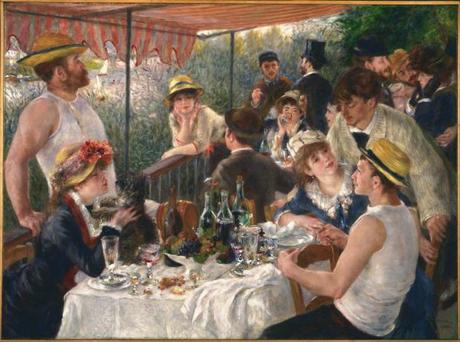
When I worked at the V&A, I met Edmund de Waal in passing several times. If I had known he had such a fascinating family history to tell, I would have engineered an opportunity to have a proper cup of tea with him, but alas, I did not. The Hare with Amber Eyes is one of those books that everyone was reading a couple of years ago; it was even sold in Tescos, which is a sure-fire sign that your book has become a hit. Therefore I, as usual, refused to join the bandwagon and assumed that it probably wouldn’t be my cup of tea anyway. However, I am currently in the process of forcing myself to read all of my unread books, so a couple of weeks ago I decided to pluck this from dusty oblivion and give it a try. I’m so glad I did, because this is an absolutely absorbing journey through the lives of several generations of de Waal’s remarkable family, and I feel richer for having read it.
The story is told through the conceit of following the journey of a collection of netsuke, or Japanese miniature figurines, from its first owner, de Waal’s great-great Uncle Charles Ephrussi in 19th century Paris, to his Great Uncle Iggie in 20th century Tokyo. This would probably be largely uninteresting if your family was from bog standard farming folk like mine, but when you consider that the Ephrussis were akin to the Rothschilds; phenomenally wealthy Jewish bankers with large families, even larger houses and a penchant for beautiful things, the premise suddenly becomes far more thrilling. I loved being transported to the world of the Belle Epoque in Paris, where Charles, an art historian and avid collector, was an intimate of such luminaries as Renoir, Monet and Proust. He had a long standing affair with a beautiful Countess, Louise Cahen-d’Anvers, whose children sat for now-famous portraits with Renoir, and hung his walls with the Impressionists before they had made their names. He is the man in the top hat at the back of Renoir’s famous Luncheon of the Boating Party, was one of the inspirations for Charles Swann in Proust’s famous novels, he knew everyone worth knowing and all of these great and good bastions of 19th century culture handled Charles’ display of netsuke that sat in his art-filled drawing room. Quite the relative.
On his cousin Viktor’s marriage at the turn of the century, Charles gave a generous wedding gift; his netsuke collection. Viktor lived in Vienna, in the phenomenally massive Palais EphrussI on Vienna’s newly built Ringstrasse. He, his wife Emmy and their children lived in palatial splendour, with hordes of servants and masses of beautiful objet d’arts. Amongst the most prominent of Jewish Viennese society, they hosted huge parties and had an enviable lifestyle, spent traveling between family estates in Switzerland, France and Czechoslovakia. However, WWII destroyed their entire way of life, and de Waal’s description of the horrific violations suffered by the Ephrussis and other Jewish people in Vienna at the hands of the Nazis were so moving that I found myself blinking back tears. Amidst the pillaging of the Ephrussi’s belongings, miraculously, some of their objects managed to survive, including the omnipresent netsuke. Rescued by Viktor and Emmy’s daughter Elisabeth after the war (the author of Persephone’s The Exiles Return) they then found their way into her brother Iggy’s apartment in post war Tokyo, back in their country of origin. This is where de Waal finds them on a visit to his beloved Great Uncle’s home, and determines to trace their history back to their first entrance into his colourful family.
De Waal writes very well, and the Ephrussi family is a gift to write about. Their role in history is now largely forgotten, but their eventful journey to riches, taking them from a modest background in the then Russian city of Odessa to the heights of their wealth and influence in Edwardian Vienna is a story that fully deserves to be told. I had no idea that so many wealthy Jewish families lived in the same, largely newly built, luxurious neighbourhoods in Europe’s cities during the late 19th century, and I had no idea that they were treated with such contempt by non Jewish contemporaries, with so many of them going on to lose their fortunes, and their lives, during the war. I felt truly educated and enlightened by the time I closed the pages of The Hare with Amber Eyes, and determined to find out more about this period of history and the prominent families who lived during it. However, I did feel that the inclusion of the netsuke was slightly self indulgent; de Waal makes it very clear that he doesn’t want to write ‘another’ book about wealthy European Jewish families, and that this is really a story about the journey of the netsuke, but let’s face it – it isn’t. It is a story about a wealthy European Jewish family, and the pages about the netsuke actually feel rather tacked on and unnecessary. I wonder why de Waal felt he couldn’t just write about his family, and that he would have to dress it up in the concept of being merely part of a wider narrative about tracing a selection of objects back to their original source. I would much rather have spent more time with the Ephrussis than the netsuke; perhaps I am alone in this, but when you have such a fascinating set of subjects to write about, why try and bury them beneath the story of a collection of inanimate objects? Yes it’s very moving to think that Proust and Renoir once touched them, but no more so than the fact that your great-great Uncle is in a famous Renoir painting, surely? Nevertheless, overall, I thought this was absolutely marvellous; it made a very pleasant change from my usual reading material and I can’t recommend it highly enough.
